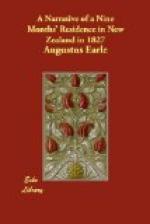November 7.—We all embarked in a canoe, in order to reach the head of the river before we began our pedestrian tour; and, after paddling about eight or nine miles further up, where the river became exceedingly narrow, we came to another English settlement. This consisted of a party of men who had come out in the Rosanna, the vessel employed by the New Zealand Company. When all ideas of settling were totally abandoned by the officers sent out for that purpose, these men chose rather to remain by themselves than to return home; and we found them busily employed in cutting timber, sawing planks, and making oars for the Sydney market. How far they may prove successful, time only can develop; but as these enterprising men had only their own industry to assist them, it could not be expected that their establishment could bear a comparison with the one at Te Horeke, which is supported by several of the most wealthy merchants of New South Wales.
As the river became narrower, the habitations of the natives were more numerous. The chief of this district (whose name is Patuone) has a splendid village very near the carpenters’ establishment we have just described. He had taken these industrious men under his especial protection, and seemed very proud of having a settlement of that kind in his territories, as it gave him power and consequence among all the neighbouring chiefs, from the trade he carried on by means of their exertions.
Patuone had likewise induced the Wesleyan missionaries to settle upon his land, about a mile below; so that the head of this river assumed quite the appearance of a civilised colony.
Our party now disembarked. We landed in a dense forest, which reached to the water’s edge; and our guides and slaves began to divide the loads each was to carry on his back. Several joined us from the two English stations on the river, and we then amounted to a very large party; all in high spirits, and anxious to proceed on our journey. When our natives had distributed the luggage, they loaded themselves, which they did with both skill and quickness; for a New Zealander is never at a loss for cords or ropes. Their plan is to gather a few handfuls of flax, which they soon twist into a very good substitute: with this material they formed slings, with which they dexterously fastened our moveables on their backs, and set off at a good trot, calling out to us to follow them.
CHAPTER VI.
Meeting with the chief Patuone.
We travelled through a wood so thick that the light of heaven could not penetrate the trees that composed it. They were so large and so close together that in many places we had some difficulty to squeeze ourselves through them. To add to our perplexities, innumerable streams intersected this forest, which always brought us Europeans to a complete standstill. The only bridges which the natives ever think of making




